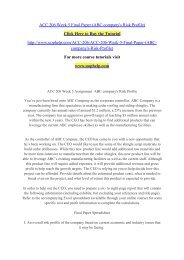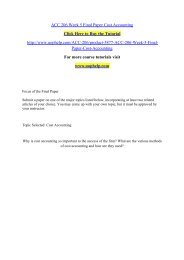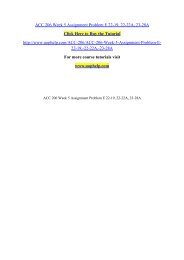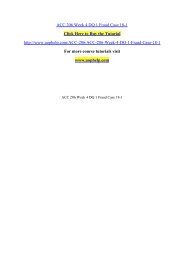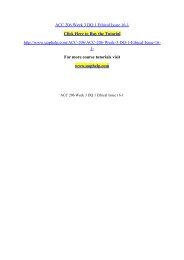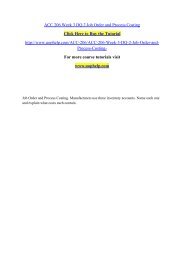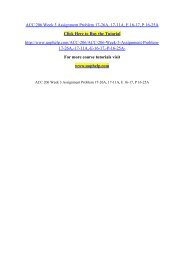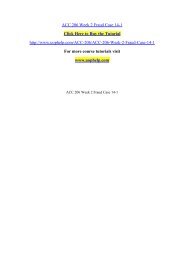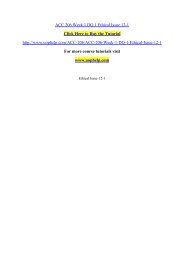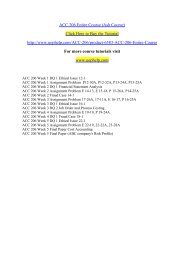ACC 205 Week 1 Exercise Assignment Basic/ UOPHELP
For more course tutorials visit www.uophelp.com 1) Basic concepts. Jean's Marine Supply specializes in the sale of boating equipment and acces¬sories. Identify the items that follow as an asset (A), liability (L), revenue (R), or expense (E) from the firm's viewpoint. The inventory of boating supplies owned by the company. (A) Monthly rental charges paid for store space. (L) A loan owed to Citizens Bank. (L) New computer equipment purchased to handle daily record keeping. (A) Daily sales made to customers. (R) Amounts due from customers. (R) Land owned by the company to be used as a future store site. (A) Weekly salaries paid to salespeople. (E)
For more course tutorials visit
www.uophelp.com
1) Basic concepts. Jean's Marine Supply specializes in the sale of boating equipment and acces¬sories. Identify the items that follow as an asset (A), liability (L), revenue (R), or expense (E) from the firm's viewpoint.
The inventory of boating supplies owned by the company. (A)
Monthly rental charges paid for store space. (L)
A loan owed to Citizens Bank. (L)
New computer equipment purchased to handle daily record keeping. (A)
Daily sales made to customers. (R)
Amounts due from customers. (R)
Land owned by the company to be used as a future store site. (A)
Weekly salaries paid to salespeople. (E)
Create successful ePaper yourself
Turn your PDF publications into a flip-book with our unique Google optimized e-Paper software.
<strong>ACC</strong> <strong>205</strong> <strong>Week</strong> 1 <strong>Exercise</strong> <strong>Assignment</strong> <strong>Basic</strong> Accounting Equations (New)<br />
Click Here To Buy The Tutorial<br />
http://www.uophelp.com/<strong>ACC</strong>-<strong>205</strong>-(New)/product-10171-<strong>ACC</strong>-<strong>205</strong>-<strong>Week</strong>-1-<br />
<strong>Exercise</strong>-<strong>Assignment</strong>-<strong>Basic</strong>-Accounting-Equations-(New)<br />
For more course tutorials visit<br />
www.uophelp.com<br />
1) <strong>Basic</strong> concepts. Jean's Marine Supply specializes in the sale of boating equipment and<br />
accessories. Identify the items that follow as an asset (A), liability (L), revenue (R), or<br />
expense (E) from the firm's viewpoint.<br />
The inventory of boating supplies owned by the company. (A)<br />
Monthly rental charges paid for store space. (L)<br />
A loan owed to Citizens Bank. (L)<br />
New computer equipment purchased to handle daily record keeping. (A)<br />
Daily sales made to customers. (R)<br />
Amounts due from customers. (R)<br />
Land owned by the company to be used as a future store site. (A)<br />
<strong>Week</strong>ly salaries paid to salespeople. (E)<br />
2) <strong>Basic</strong> computations. The following selected balances were extracted from the<br />
accounting records of Rossi Enterprises on December 31, 20X3:<br />
Accounts Payable $3,200 Interest Expense $2,500<br />
Accounts Receivable 14,800 Land 18,000<br />
Auto Expense 1,900 Loan Payable 40,000<br />
Building 30,000 Tax Expense 3,300<br />
Cash 7,400 Utilities Expense 4,100<br />
Fee Revenue 56,900 Wage Expense 37,500<br />
a. Determine Rossi’s total assets as of December 31.<br />
b. Determine the company’s total liabilities as of December 31.<br />
c. Compute 20X3 net income or loss.<br />
3. Balance sheet preparation. The following data relate to Preston Company as of<br />
December 31, 19XX:<br />
Building $44,000 Accounts receivable $24,000<br />
Cash 17,000 Loan payable 30,000<br />
J. Preston, Owners Equity 65,000 Land 21,000<br />
Accounts payable ?<br />
Prepare a balance sheet as of December 31, 19XX. (See Exhibit 1.1 and 1.4)<br />
4. <strong>Basic</strong> transaction processing. On November 1 of the current year, Richard Parker<br />
established a sole proprietorship. The following transactions occurred during the month:<br />
1: Parker invested $19,000 into the business.<br />
2: Paid $9,000 to acquire a used minivan.<br />
3: Purchased $1,800 of office furniture on account.<br />
4: Performed $2,100 of consulting services on account.
5: Paid $300 of repair expenses.<br />
6: Received $800 from clients who were previously billed in item 4.<br />
7: Paid $500 on account to the supplier of office furniture in item 3.<br />
8: Received a $150 electric bill, to be paid next month.<br />
9: Parker withdrew $600 from the business.<br />
10: Received $250 in cash from clients for consulting services rendered.<br />
Instructions<br />
a. Arrange the following asset, liability, and owner’s equity elements of the accounting<br />
equation: Cash, Accounts Receivable, Office Furniture, Van, Accounts Payable,<br />
Investments/Withdrawals, and Revenues/Expenses. (See Exhibit 5)<br />
b. Record each transaction on a separate line. After all transactions have been recorded,<br />
compute the balance in each of the preceding items.<br />
c. Answer the following questions for Parker.<br />
(1) How much does the company owe to its creditors at month-end? On which financial<br />
statement(s) would this information be found?<br />
(2) Did the company have a “good” month from an accounting viewpoint? Briefly explain.<br />
5. Transaction analysis and statement preparation. The transactions that follow relate to<br />
Burton Enterprises for March 20X1, the company’s first month of activity.<br />
3/1: Joanne Burton, the owner invested $20,000 into the business.<br />
3/4: Performed $2,400 of services on account.<br />
3/7: Acquired a small parcel of land by paying $6,000 cash.<br />
3/12: Received $700 from a client, who was billed previously on March 4.<br />
3/15: Paid $800 to the Journal Herald for advertising expense.<br />
3/18: Acquired $9,000 of equipment from Park Central Outfitters by paying<br />
$7,000 down and agreeing to remit the balance owed within the next<br />
2 weeks, (Accounts Payable).<br />
3/22: Received $300 cash from clients for services.<br />
3/24: Paid $1,500 on account to Park Central Outfitters in partial settlement<br />
of the balance due from the transaction on March 18.<br />
3/28: Rented a car from United Car Rental for use on March 28. Total charges<br />
amounted to $75, with United billing Burton for the amount due.<br />
3/31: Paid $900 for March wages.<br />
3/31: Processed a $600 cash withdrawal from the business for Joanne Burton.<br />
Instructions<br />
a. Determine the impact of each of the preceding transactions on Burton’s assets, liabilities,<br />
and owner’s equity. See exhibit 1.5. Use the following format:<br />
Assets = Liabilites + Owner's Equity<br />
Cash,<br />
Accounts<br />
Receivable,<br />
Land,<br />
Equipment<br />
Accounts<br />
Payable<br />
(+) Investments<br />
(+) Revenues (-)<br />
Withdrawals (-)<br />
Expenses<br />
a. Record each transaction on a separate line. Calculate balances only after the last transaction<br />
has been recorded.<br />
b. Prepare an income statement, a statement of owner’s equity, and a balance sheet, (See<br />
Exhibit 1.1, 1.3 and 1.4)
6. Recognition of normal balances<br />
The following items appeared in the accounting records of Triguero's, a retail music store that<br />
also sponsors concerts. Classify each of the items as an asset, liability; revenue; or expense<br />
from the company's viewpoint. Also indicate the normal account balance of each item.<br />
a. The albums, tapes, and CDs held for sale to customers.<br />
b. A long-term loan owed to Citizens Bank.<br />
c. Promotional costs to publicize a concert.<br />
d. Daily receipts for merchandise sold,<br />
e. Amounts due from customers,<br />
f. Land held as an investment,<br />
g. A new fax machine purchased for office use.<br />
h. Amounts to be paid in 10 days to suppliers,<br />
i. Amounts paid to a mall for rent.<br />
7.<strong>Basic</strong> journal entries<br />
The following transactions pertain to the Jennifer Royall Company:<br />
Jennifer Royall invested cash of $15,000 and land valued<br />
Apr. 1<br />
at $10,000 from into the business.<br />
Provided $1,200 of services to Jason Ratchford, a client, on<br />
5<br />
account.<br />
9 Paid $250 of salaries to an employee.<br />
14 Acquired a new computer for $3,200, on account.<br />
Collected $800 from Jason Ratchford for services provided<br />
20<br />
on April 5.<br />
Borrowed $7,500 from BestBanc by securing a six-month<br />
24<br />
loan.<br />
Prepare journal entries (and explanations) to record the preceding transactions and events.<br />
8. Trial balance preparation. Brighton, a sole proprietorship began operation on March 1 of<br />
the current year. The following account balances were extracted from the general ledger on<br />
March 31; all accounts have normal balances.<br />
Accounts Payable $ 12,000Interest Expense $ 300<br />
Accounts Receivable 8,800Land ?<br />
Advertising Expense 5,700Loan Payable 26,000<br />
Bob Brighton, Owners Equity 30,000Salaries Expense 11,100<br />
Cash 22,500Utilities Expense 700<br />
Fees<br />
Earned 18,900<br />
a. Determine the cost of the company’s land by preparing a trial balance. (Remember, the<br />
trial balance debits must equal the credits, see Exhibit 2.9)<br />
b. Determine the firm’s net income for the period ending March 31.<br />
9. Entry and trial balance preparation. Lee Adkins is a portrait artist. The following<br />
schedule represents Lee’s combined chart of accounts and trial balance as of May 31.<br />
Account number Account<br />
name Debit Credit<br />
110 Cash $ 2,700
120 Accounts Receivable 12,100<br />
130 Equipment and Supplies 2,800<br />
140 Studio 45,000<br />
210 Accounts Payable $2,600<br />
310 Lee Adkins, Owners Equity 57,400<br />
320 Lee Adkins, Drawing 30,000<br />
410 Revenue 39,000<br />
510 Advertising Expense 2,300<br />
520 Salaries Expense 2,100<br />
540 Utilities Expense 2,000<br />
$99,000 $99,000<br />
The general ledger also revealed account no. 530, Legal and Accounting Expense. The<br />
following transactions occurred during June:<br />
6/2:Collected $7,500 on account from customers.<br />
6/7:Sold 25% of the equipment and supplies to a young artist for $700 for cash<br />
Received a $500 bill from the accountant for preparing last quarter’s<br />
6/10:<br />
financial statements.<br />
6/15:Paid $2,100 to creditors on account.<br />
6/27:Adkins withdrew $1,000 cash for personal use.<br />
6/30:Billed a customer $3,000 for a portrait painted this month.<br />
a. Record the necessary journal entries for June on page 2 of the company’s general journal.<br />
(See Exhibit 2.6)<br />
b. Open running balance ledger “T” accounts by entering account titles, account numbers,<br />
and May 31 balances. (See exhibit 2.3 and 2.4)<br />
c. Post the journal entries to the “T” accounts.<br />
d. Prepare a trial balance as of June 30. (See exhibit 2.9)<br />
10. Journal entry preparation. On January 1 of the current year, Peter Houston invested<br />
$100,000 cash into his company MuniServ. Shortly thereafter, the company acquired<br />
selected assets of a bankrupt competitor. The acquisition included land ($15,000), a building<br />
($40,000), and vehicles ($10,000). MuniServ paid $45,000 at the time of the transaction and<br />
agreed to remit the remaining balance due of $20,000 (an account payable) by February 15.<br />
During January, the company had additional cash outlays for the following items:<br />
Purchases of store equipment $4,600<br />
Loan payment 500<br />
Salaries expense 2,300<br />
Advertising expense 700<br />
The January utilities bill of $200 was received on January 31 and will be paid on February 10.<br />
MuniServ rendered services to clients on account amounting to $9,400 and $3,700 had been<br />
received in settlement.<br />
Instructions<br />
a. Present journal entries that reflect MuniServ's January transactions, starting with<br />
the $100,000 investment. (See exhibit 2.6)<br />
b. Compute the total debits, total credits, and ending balance that would be found in<br />
the company's Cash account. (Post to “T” Accounts, see exhibit 2.3 and 2.4)
c. Prepare a trail balance as of January 31. (See exhibit 2.9)



